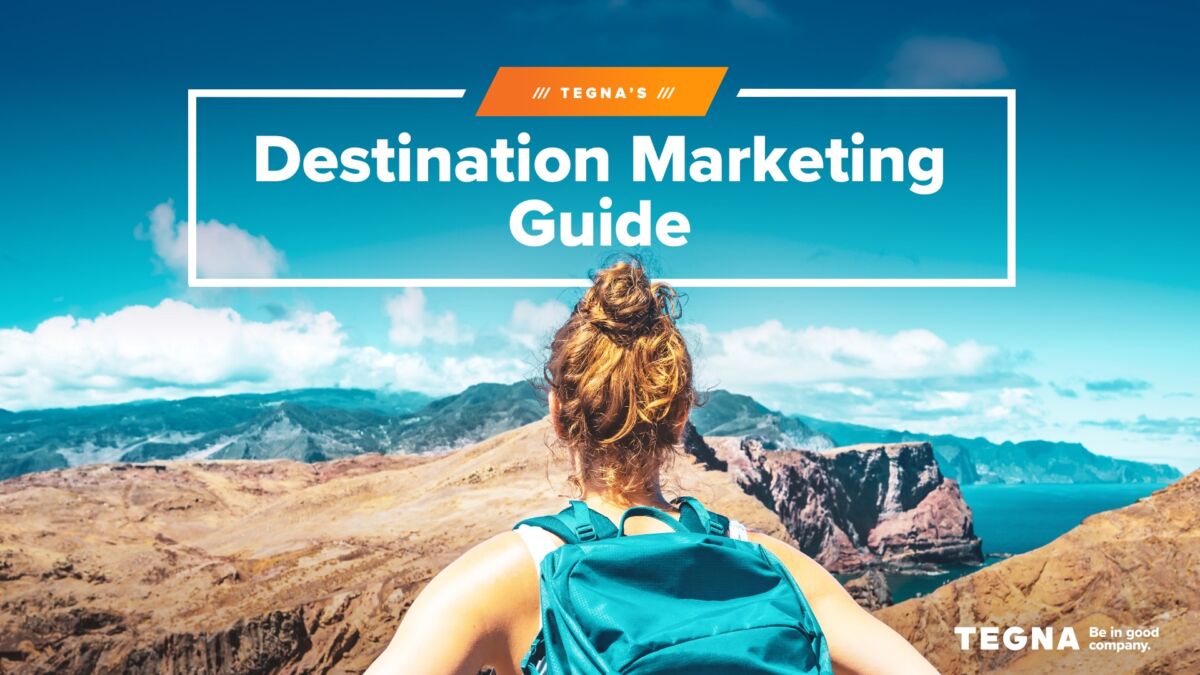Your Guide to Destination Marketing
Destination marketing can elevate your destination and boost visibility. Read our guide to understand how you can add value through a well-crafted campaign.

With rest, relaxation, and family and friend reunions at the core behind the expected boom in travel and tourism, attracting visitors to a destination is top of mind for most marketing pros in the space.
What’s the best way to attract tourists, visitors, and businesses to your destination? And how do you keep them coming back year after year?
We’ve pulled all the insights you’ll need from our latest e-book, “Understanding Today’s Leisure Traveler,” to create a destination marketing campaign that creates awareness and interest by showcasing everything unique about your destination.
Let’s hit the road.
What is Destination Marketing?
Commonly used by states, cities, and smaller regions, destination marketing is an essential component of the tourism and hospitality industry that focuses on attracting tourists, visitors, and businesses to a specific location.
A common goal of destination marketing is to generate awareness and interest in a specific location by showcasing a place’s unique attributes and experiences, encouraging people to visit and create unforgettable memories. The practice can also lead to increased tourism, economic growth, job creation, and additional investments in that destination, which can benefit the community and its residents long-term.
How & Why Does Destination Marketing Add Value?
Destination marketing adds value by boosting your destination’s visibility to a broad audience but also helps boost economic growth, create jobs, enhance infrastructure, preserve culture, improve residents’ quality of life, and foster cultural exchange and understanding. On top of that, destination marketing can:
Allow for Collaborations & Partnerships
Destination marketing opens doors for collaborations and partnerships with other businesses and organizations. Local businesses, hotels, restaurants, and attractions can all benefit from working with a partner, like your local broadcast TV station, to enhance the visitor experience.
Brings About Market Research
In marketing your destination, you gain valuable insights into your target audience, which is critical to creating an effective campaign. Understanding your audience’s preferences, behaviors, and expectations can help you tailor your offerings and marketing strategies to their needs, wants, and expectations.
Economic Growth
Destination marketing helps economic growth as tourists spend money on accommodations, food, activities, and souvenirs, stimulating the local economy and creating jobs in hospitality, transportation, and entertainment, as well as suppliers, construction workers, and those supporting infrastructure development. A well-marketed destination can also attract business investment. Companies may choose to open new locations or expand existing ones in a destination gaining popularity. This can also help build a sense of community and improve infrastructure, amenities, and property values for residents.
3 Best Practices for Destination Marketing Campaigns
Successful destination marketing campaigns rely on various best practices to attract and engage visitors. Here are some key strategies to consider:
1. Leverage Video Advertising
In the captivating realm of travel and tourism, where the allure of places near and far call out, the power of video advertising holds a remarkable sway. Visual content, such as videos and images, can captivate potential visitors and preview what they can expect. Therefore, a cross-platform strategy, including television, streaming, and digital video advertising, can reach a broad audience and effectively showcase your destination’s beauty and attractions.
2. Take Advantage of Influencer Marketing
Partnering with influencers who align with your destination’s values and aesthetics can help reach a broader audience and build credibility. Our study found that destinations can benefit from the influence and the halo effect provided by their local and regional news stations. Trust extends to brands that advertise with trustworthy content, and local news viewers are more likely to take notice of those brands. People who consume travel content also believe their local news informs travel and trust local recommendations over national news. Viewers rely on local news stations to educate them about nearby tourist activities (59%) and the latest travel trends (44%).
3. Include Realism
Understanding Today’s Leisure Traveler finds that honesty is key in destination marketing, and you’ll want to portray your destination accurately to meet and exceed visitors’ expectations. Our study finds that while everyone dreams of an all-inclusive getaway at a luxury resort, it’s not a realistic possibility for all. With the rise in staycations in mind, some consumers want to see more affordable destinations located closer to home and less crowded than big, main event attractions.
Advantages of Destination Marketing
Destination marketing plays a pivotal role in shaping the success and image of a location. It has the power to:
- Drive Tourism: Destination marketing can increase visitor numbers by showcasing a location’s unique attractions and experiences.
- Stimulate Economic Growth: This influx of tourists contributes significantly to the local economy. Restaurants, hotels, shops, and entertainment venues benefit from increased demand, leading to higher revenues and employment opportunities.
- Attract Investment: Investors are more likely to be drawn to regions with solid destination marketing campaigns highlighting business-friendly environments, available resources, and the potential for high returns.
- Promote Cultural Exchange: Destination marketing encourages cultural exchange and a deeper understanding between residents and visitors by showcasing the local culture and history. This can lead to enriched cultural experiences and promote tolerance and mutual respect.
By focusing on the advantages of destination marketing, regions, and destinations can leverage their strengths and position themselves as attractive, thriving places in our globalized world. This, in turn, benefits everyone involved, from tourists seeking memorable experiences to residents who take pride in their vibrant, welcoming communities.
Challenges of Destination Advertising
While destination advertising has numerous advantages, it has its fair share of challenges. Acknowledging and addressing these challenges will help you develop more effective and sustainable advertising strategies, ensuring their long-term appeal to tourists, residents, and investors. Here are some common obstacles:
- Competition: Competition is fierce, and standing out in a crowded marketplace can be a significant challenge, especially for destinations with limited resources and brand recognition.
- Changing Consumer Behavior: Consumer behavior and preferences are constantly evolving. Destinations must adapt to their target audience’s changing needs and desires, as outlined in our new study, “Understanding Today’s Leisure Traveller.”
- Seasonal Fluctuations: Many destinations experience seasonal variations in visitor numbers. Advertising must consider these fluctuations and develop strategies to attract tourists during off-peak times.
- Sustainability Concerns: Balancing the desire for increased tourism with the need for sustainability and responsible tourism practices can be a delicate and complex challenge.
- Negative Perceptions: Some destinations may have existing negative perceptions due to political issues, safety concerns, or stereotypes.
Examples of Destination Marketing
Kate Cox and Cochise County is just one example of a tremendous cross-channel marketing campaign in partnership with TEGNA’s 12 News in Phoenix. The campaign leveraged TV, streaming, and digital elements to attract visitors from near and far.
These elements included content featured on Arizona Midday to engage a broad and diverse audience, including their target audience of foodies and wine lovers, outdoor adventurists, young families, and culture and history buffs.
The campaign was also bolstered through strategic streaming and retargeting efforts, resulting in impressive Video Completion Rates (VCR) of 97% and retargeting click-through at nearly three times higher than industry averages, affirming the partnership’s success and paving the way for future collaboration.
Help Travelers Get Away with TEGNA
At TEGNA, our ultimate goal is to equip brands with data and insights to inform and develop creative, then amplify those messages with cross-platform campaigns, including linear, streaming, and digital elements. With 64 broadcast stations in 51 markets nationwide, our unique content opportunities will connect your business to the audiences that matter most and deliver proven results. Let’s get in touch to see how we can help your brand grow with the power of TV advertising.
Frequently Asked Questions
What is the difference between place marketing and destination marketing?
Place marketing is a broader concept encompassing marketing efforts for regions, cities, or countries. On the other hand, destination marketing focuses explicitly on promoting tourist destinations within those places.
What is an example of destination branding?
New York City’s iconic “I ❤ NY” campaign is an excellent example of destination branding. This simple yet powerful logo and slogan have built brand fame, become synonymous with the city, and are instantly recognizable worldwide.
What is destination digital marketing?
Destination digital marketing involves using digital channels such as websites, social media, email marketing, and online advertising to promote a destination, attract visitors, and engage with potential tourists effectively.






















